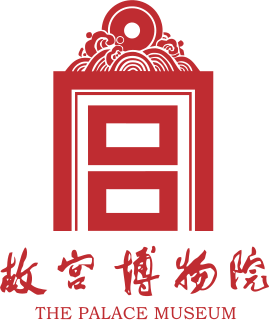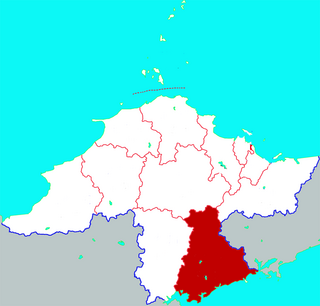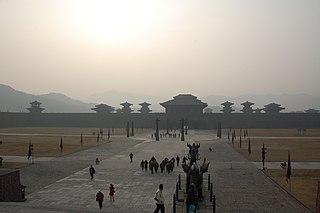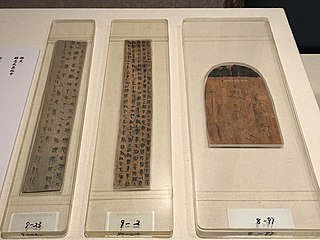
The Xiang River is the chief river of the Lake Dongting drainage system of the middle Yangtze, the largest river in Hunan Province, China. It is the 2nd largest tributary in terms of surface runoff, the 5th largest tributary by drainage area of the Yangtze tributaries. The river flows generally northeast through Guangxi and Hunan two provinces, its tributaries reach into Jiangxi and Guangdong.

The Palace Museum is a national museum housed in the Forbidden City at the core of Beijing. It was established in 1925 after the last Emperor of China was evicted from his palace, and opened its doors to the public.

Hangu Pass or Hanguguan is a pass separating the upper Yellow River and Wei valleys—the cradle of Chinese civilization and seat of its longtime capital Xi'an—from the fertile North China Plain. It lies on the south bank of the Yellow River just east of its eastward bend out of the Ordos Loop at Tong Pass in Shaanxi. It was the site of many battles during the Warring States and early imperial eras, when it was the chokepoint shielding Qin, Guanzhong, or Luoyang from outside attack. Today, the term Hangu Pass refers to two locations: firstly, to a museum park including a reconstruction of the gate in Lingbao county, Sanmenxia city, Henan and secondly, to the archaeological site of the gate in Xin’an county, Luoyang city, Henan. In 2014, the archeological site was recognized by UNESCO as part of the “Silk Roads: the Routes Network of Chang'an-Tianshan Corridor” World Heritage Site.

Xintai is a county-level city in the central part of Shandong province, People's Republic of China. It is the easternmost county-level division of the prefecture-level city of Tai'an and is located about 50 kilometres (31 mi) to the southeast of downtown Tai'an.

Basket weaving is the process of weaving or sewing pliable materials into three-dimensional artifacts, such as baskets, mats, mesh bags or even furniture. Craftspeople and artists specialized in making baskets may be known as basket makers and basket weavers. Basket weaving is also a rural craft.

Anji County (help·info) is a county in the prefecture-level city of Huzhou in northwestern Zhejiang province, People's Republic of China, with a population of 461,800 as of the end of 2013. Anji county is well known for its 60,000 hectares of bamboo groves containing over 40 different species of bamboo. It has been designated a pilot county for ecological and green building construction.

Haiyang, a coastal city in Shandong province in eastern China, located on the Yellow Sea (southern) coast of the Shandong Peninsula. It is a county-level city under the administration of the prefecture-level city of Yantai.

Hengdian World Studios is a film studio located in Hengdian, a Chinese town in the city of Dongyang, Zhejiang Province. It is the largest film studio in the world. The movie studio is operated by the privately owned Hengdian Group founded by Xu Wenrong. Xu turned acres of farmland in central Zhejiang into the largest movie studio in Asia. Construction began in the mid-1990s and has been ongoing ever since with the possible recent addition of the replica of the Old Summer Palace. A film about extras working at the studio, I Am Somebody, was released in China in 2015.

Rise of the Great Wall is a 1986 Hong Kong television series based on the life of Qin Shi Huang, the First Emperor of China and founder of the Qin dynasty. The series is one of the biggest productions by ATV.

Yunjin, Nanjing brocade or Cloud brocade, is a traditional Chinese luxury silk brocade made in Nanjing since the end of the Song dynasty, and based on weft-weaving techniques from both the Song and Tang dynasties. It is shuttle-woven, and often incorporates gold and silver threads with the coloured silks. During the Ming dynasty, the yunjin weavers developed a technique of swivel weaving that enabled them to weave colourful designs onto a base fabric in other weaves, such as satin. In 2009, Nanjing brocade was selected into the representative list of oral and intangible heritage of humanity at UNESCO.
Bamboo weaving is a form of bambooworking and a traditional craft of Taiwan.
Anji Play is an early childhood curriculum designed by Cheng Xueqin, Director, Office of Pre-Primary Education, Anji County Department of Education, Zhejiang Province. The key elements that make up Anji Play are its pedagogy, site-specific environments, unique materials and integrated technology. The focus of the program is the participating children's self-determination in choosing what, where, and with whom to play and the role of the teacher as observer, particularly in instances of physical risk. Anji Play is the full-time curriculum of all public kindergartens in Anji County.

Jizhou ware or Chi-chou ware is Chinese pottery from Jiangxi province in southern China; the Jizhou kilns made a number of different types of wares over the five centuries of production. The best known wares are simple shapes in stoneware, with a strong emphasis on subtle effects in the dark glazes, comparable to Jian ware, but often combined with other decorative effects. In the Song dynasty they achieved a high prestige, especially among Buddhist monks and in relation to tea-drinking. The wares often use leaves or paper cutouts to create resist patterns in the glaze, by leaving parts of the body untouched.

The Liye Qin Slips is a large collection of bamboo slips which were unearthed from Liye Ancient City in Longshan County, Hunan, China in 2002. It is one of China's most important archaeological discoveries of the 21st century. Archaeologists found more than 37,000 pieces of bamboo slips, on which more than 200,000 Chinese characters record government and legal documents of the Qin dynasty. It is considered the most important archaeological discovery of the Qin dynasty after the Terracotta Army unearthed in 1973 in Xi'an.
Liye is a town of Longshan County, Hunan Province, China. Located on the northern bank of You River, Liye is the southernmost town of the county, and bordered to the west by Youshuihe Town and Keda Township of Youyang County, Daxi Township of Xiushan County of Chongqing Municipality, to the south by Qingshuiping and Bier Towns of Baojing County, to the east and southeast by Maoertan Town, to the southwest by Zaguo Township. The present-day Liye was reformed on November 30, 2015. It covers an area of 259.2 square kilometres (100.1 sq mi), as of November, 2015, it has a registered population of 43,300, the seat is Liye Community.
The Liye Qin Slips Museum is a museum of bamboo and wooden slips of the Qin dynasty unearthed in 2002. It is located in the northeast of seat of Liye Town, Longshan County, Hunan Province, China. The Museum was officially opened on October 28, 2010, it covers an area of 36,000 square metres with a building area of 7,200 square metres.
The Liye Ancient City is an archaeological site in Liye Town, Longshan County, Hunan Province, China. It was of seat of the ancient Qianling County in Dongting Commandery of the Qin dynasty. It is known for 37,400 Qin bamboo slips unearthed in 2002. The city was built by the Kingdom of Chu in the late Warring States period, reconstructed in the Qin dynasty and abandoned in the early Western Han dynasty. It was approved as a historical and cultural site protected at the national level in Hunan on November 22, 2002. The Liye Qin Slips Museum and the Ruins Park were officially opened on October 28, 2010.

The Baoji Bronzeware Museum is an archaeology museum in Baoji, Shaanxi, China. It has a collection of more than 120,000 pieces of cultural relics through the ages, most of them are Zhou dynasty bronze wares. Baoji Bronze Ware Museum's present building, which opened in 2010, occupies an area of more than 50,800 square metres (547,000 sq ft), with a total floor space of 34,788 square metres (374,450 sq ft).
Hanfu also includes accessories, such as footwear. There were many etiquettes which rule people's daily lives, and this included the use and etiquettes of shoes and socks wearing.

Shubi, also called as zhi, is a generic term used for Chinese combs in China, which includes thick-teeth comb shu and thin-teeth comb bi. Shubi originated about 6000 years ago in China during the late Neolithic period. Some Chinese combs dating from the Shang dynasty were found in the Tomb of Fuhao. In ancient China, Chinese combs had a high special status, a high artistic value, was an important form of hair ornament in Chinese history. Chinese comb also had and continues to hold unique cultural meaning and emotional value. Chinese combs in China were not used only for grooming purposes, they were also used holding and decorating hair. Both Chinese men and women wore decorative combs in their hair in ancient China. Chinese women often wore combs and fine-tooth combs in their hair buns. Chinese comb-making was also an important form of traditional Chinese art and business industry.
















